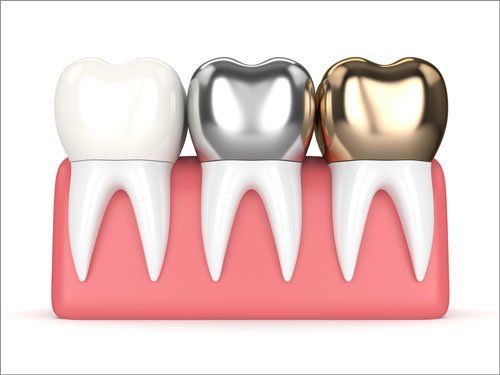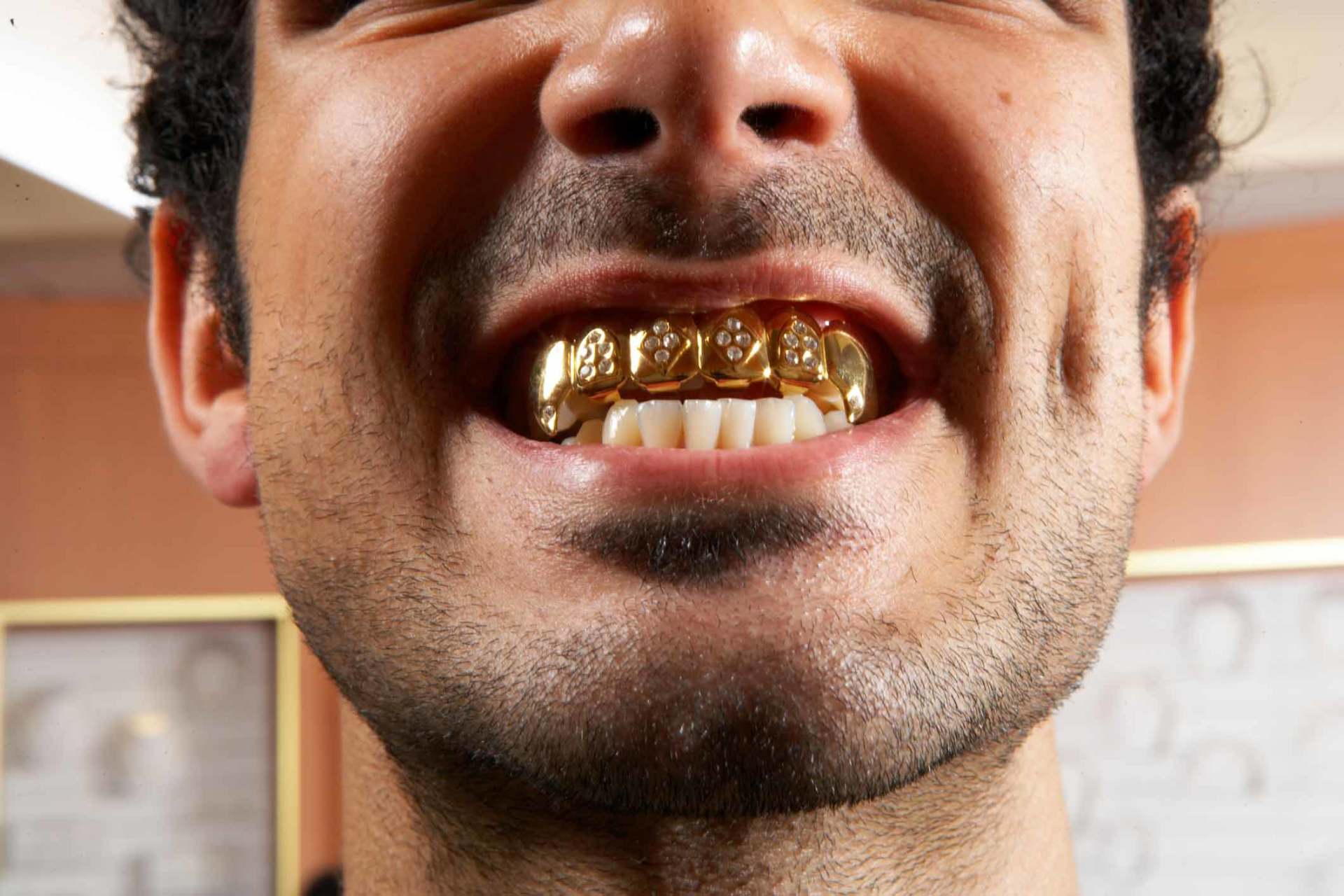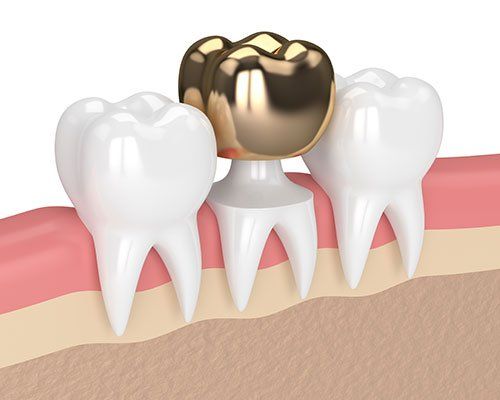Should You Use Bonding or Cementing for Gold Crowns?
- By Admin
- •
- 06 Nov, 2018
- •

Some people think that the only way to deal with a severely damaged tooth is to extract it. Today, however, dentists can restore teeth in many ways.
Your dentist's goal is to help you maintain as much of your natural tooth as you can, and a gold crown can protect what’s left. Dentists can place crowns over fractured teeth and teeth that need root canals or cannot support fillings.
Your dentist's goal is to help you maintain as much of your natural tooth as you can, and a gold crown can protect what’s left. Dentists can place crowns over fractured teeth and teeth that need root canals or cannot support fillings.
Gold crowns have many benefits, including:
- Resistance to galvanic charge
- Resistance to wear and tear
- Improved tooth integrity
Gold is also a great choice for those with metal allergies.
If gold crowns sound like a good choice, you'll also need to figure out whether you want them bonded or cemented.
If gold crowns sound like a good choice, you'll also need to figure out whether you want them bonded or cemented.
What's the Difference Between Bonded Crowns and Cemented Crowns?
Cemented crowns are sealed, or luted, to a tooth. Luting agents basically glue a restoration to a tooth. Luting agents will link the gold crown (or another prosthesis) to the prepared enamel.
When a dentist bonds a crown to a tooth, they use an etching system and light curing system. First, the dentist performs acid etching, using maleic or phoric acid gel to roughen the surface of the enamel. This rough surface helps to retain the bonding material.
When the dentist places the bonding agent, they use a curing light to harden the material. Instead of just physically attaching or cementing the gold crown, bonding systems chemically alter substances for a stronger seal.
When a dentist bonds a crown to a tooth, they use an etching system and light curing system. First, the dentist performs acid etching, using maleic or phoric acid gel to roughen the surface of the enamel. This rough surface helps to retain the bonding material.
When the dentist places the bonding agent, they use a curing light to harden the material. Instead of just physically attaching or cementing the gold crown, bonding systems chemically alter substances for a stronger seal.
Is One Method Better Than Another?
Like any dental procedure, each method had pros and cons.
The Pros and Cons of Cementing
While bonding is often seen as a superior solution because of its strength, it may not be the right fit for you. For example, if your teeth are very prone to decay, you may want to stick with cementing. Cements are made of thin films, so it takes less time to remove a cemented crown. If you had frequent cavities in the past, you may want to cement the gold crown so a dentist can easily check underneath if needed.
Some cements, like glass ionomer cement, are designed to help those with receding gum lines or erosion. Glass ionomer cement slowly releases fluoride, so again, if you have had frequent decay or a root canal, this cement can stop recurring issues by remineralizing teeth.
The big downside of cement is that the restoration won't be as strong as it could be. Over time, natural chewing forces will weaken the cement and loosen the crown.
The Pros and Cons of Bonding
If an external event — like a sports injury — caused damage to your tooth, then bonding may be better. With only external damage, you don’t need to worry about any decay.
One great benefit of bonding is that the restoration margins look better than cemented ones. A margin is simply the boundary at the gumline between a restoration and the natural tooth. For example, porcelain-fused-to-metal crowns are notorious for having dark lines in the marginal area, as the metal portion of the crown is exposed.
Besides improved aesthetics, the biggest benefit is strength. Nothing beats the strength of your natural teeth, but gold comes pretty close. Your gold crown will last you a very long time, so with good care, you won't have to worry about replacing it often.
Go to a dentist who is experienced in bonding techniques, as a downside of bonding is the extended prep work. Preparation requires adequately cleaning the site of moisture and isolating the tooth. An experienced dentist will make quick work of both the prep and the procedure.
You will want to talk with a dentist for more information on gold crown placement. Contact Gold Teeth Baton Rouge for professional services today.
While bonding is often seen as a superior solution because of its strength, it may not be the right fit for you. For example, if your teeth are very prone to decay, you may want to stick with cementing. Cements are made of thin films, so it takes less time to remove a cemented crown. If you had frequent cavities in the past, you may want to cement the gold crown so a dentist can easily check underneath if needed.
Some cements, like glass ionomer cement, are designed to help those with receding gum lines or erosion. Glass ionomer cement slowly releases fluoride, so again, if you have had frequent decay or a root canal, this cement can stop recurring issues by remineralizing teeth.
The big downside of cement is that the restoration won't be as strong as it could be. Over time, natural chewing forces will weaken the cement and loosen the crown.
The Pros and Cons of Bonding
If an external event — like a sports injury — caused damage to your tooth, then bonding may be better. With only external damage, you don’t need to worry about any decay.
One great benefit of bonding is that the restoration margins look better than cemented ones. A margin is simply the boundary at the gumline between a restoration and the natural tooth. For example, porcelain-fused-to-metal crowns are notorious for having dark lines in the marginal area, as the metal portion of the crown is exposed.
Besides improved aesthetics, the biggest benefit is strength. Nothing beats the strength of your natural teeth, but gold comes pretty close. Your gold crown will last you a very long time, so with good care, you won't have to worry about replacing it often.
Go to a dentist who is experienced in bonding techniques, as a downside of bonding is the extended prep work. Preparation requires adequately cleaning the site of moisture and isolating the tooth. An experienced dentist will make quick work of both the prep and the procedure.
You will want to talk with a dentist for more information on gold crown placement. Contact Gold Teeth Baton Rouge for professional services today.




